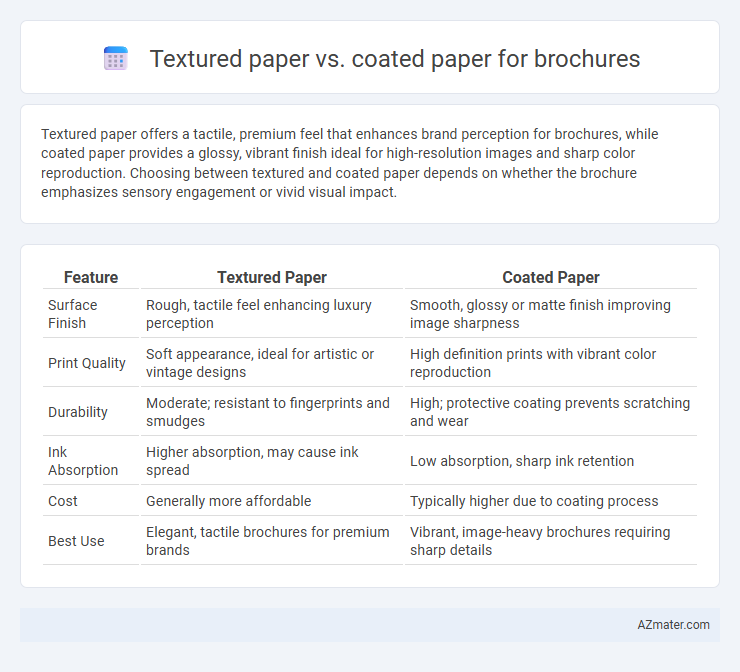Textured paper offers a tactile, premium feel that enhances brand perception for brochures, while coated paper provides a glossy, vibrant finish ideal for high-resolution images and sharp color reproduction. Choosing between textured and coated paper depends on whether the brochure emphasizes sensory engagement or vivid visual impact.
Table of Comparison
| Feature | Textured Paper | Coated Paper |
|---|---|---|
| Surface Finish | Rough, tactile feel enhancing luxury perception | Smooth, glossy or matte finish improving image sharpness |
| Print Quality | Soft appearance, ideal for artistic or vintage designs | High definition prints with vibrant color reproduction |
| Durability | Moderate; resistant to fingerprints and smudges | High; protective coating prevents scratching and wear |
| Ink Absorption | Higher absorption, may cause ink spread | Low absorption, sharp ink retention |
| Cost | Generally more affordable | Typically higher due to coating process |
| Best Use | Elegant, tactile brochures for premium brands | Vibrant, image-heavy brochures requiring sharp details |
Introduction to Textured and Coated Paper
Textured paper features a tactile surface that adds depth and a unique feel to brochures, enhancing the sensory experience and making designs stand out. Coated paper, on the other hand, has a smooth, glossy or matte finish that intensifies colors and sharpens images for a polished, professional look. The choice between textured and coated paper significantly impacts the brochure's visual appeal and perceived quality.
Understanding Textured Paper: Features and Benefits
Textured paper for brochures offers a tactile surface that enhances visual appeal and creates a unique sensory experience, making it ideal for luxury brands and artistic designs. Its absorbent fibers result in richer color depth and reduced glare, ensuring vibrant and clear imagery while providing a premium, handcrafted feel. This paper type is durable, less prone to fingerprints and smudges, and adds an element of sophistication that helps brochures stand out in competitive markets.
Exploring Coated Paper: Properties and Advantages
Coated paper features a smooth, glossy or matte finish achieved by applying a surface coating of clay or polymer, enhancing ink adhesion and color vibrancy for brochures. Its superior opacity and resistance to ink bleed make it ideal for detailed images and sharp text, ensuring professional-quality prints. This type of paper also offers durability against wear and moisture, extending the brochure's lifespan and maintaining visual appeal in various handling conditions.
Visual Appeal: Textured vs Coated Paper for Brochures
Textured paper offers a tactile dimension with its raised surfaces, enhancing visual appeal through subtle shadows and a handcrafted feel that engages viewers beyond color and print quality. Coated paper provides a smooth, glossy finish that amplifies color vibrancy and sharpness, making images and graphics stand out with high-definition clarity ideal for polished, professional brochures. Choosing between textured and coated paper depends on desired aesthetics: textured paper suits luxury or artisanal branding, while coated paper excels in delivering bright, eye-catching visuals.
Print Quality and Color Vibrancy
Textured paper enhances tactile appeal and provides a unique, sophisticated finish but often absorbs more ink, leading to slightly muted colors and less sharp print quality compared to coated paper. Coated paper features a smooth, glossy or matte surface that intensifies color vibrancy and sharpness, making images and graphics pop with high definition. For brochures requiring vivid visuals and crisp detail, coated paper is ideal, while textured paper suits designs emphasizing elegance and tactile engagement.
Tactile Experience: Touch and Feel Comparison
Textured paper enhances the tactile experience of brochures by providing a distinct, raised surface that adds depth and sophistication to printed materials, making them memorable to touch. Coated paper offers a smooth, glossy or matte finish that accentuates color vibrancy and sharpness, but lacks the unique tactile engagement of textured options. Choosing textured paper for brochures emphasizes sensory appeal and luxury, while coated paper prioritizes visual impact and image clarity.
Suitability for Different Brochure Styles
Textured paper enhances luxury brochure designs by providing a tactile, elegant finish ideal for high-end brands and artistic presentations. Coated paper offers a smooth, glossy surface that makes vibrant images and detailed graphics stand out, perfect for marketing campaigns emphasizing visual impact. Choosing between textured and coated paper depends on whether the brochure style prioritizes tactile sophistication or sharp, colorful imagery.
Durability and Longevity
Textured paper offers enhanced durability due to its thicker fibers and resistance to wear, making it ideal for long-lasting brochures that withstand frequent handling. Coated paper, while providing a smooth, glossy finish that enhances image quality and color vibrancy, tends to be more susceptible to scratches and creasing over time. For brochures requiring extended longevity and a tactile feel, textured paper is the superior choice compared to coated paper's aesthetic emphasis.
Cost Considerations for Brochure Printing
Textured paper typically incurs higher costs than coated paper due to its specialty finishes and manufacturing processes, which can impact overall brochure printing budgets. Coated paper offers a more economical solution, providing smooth surfaces ideal for vibrant color reproduction at a lower price point. Businesses weighing cost considerations for brochure printing often choose coated paper to balance quality and affordability, especially for large print runs.
Choosing the Right Paper for Your Brochure Project
Textured paper offers a tactile surface that enhances the sensory experience, ideal for luxury or artisanal brochures aiming to convey quality and uniqueness. Coated paper provides a smooth finish with vibrant color reproduction, perfect for brochures requiring sharp images and bold graphics. Selecting the right paper depends on the desired aesthetic, budget, and the emotional impact you want to achieve with your brochure.

Infographic: Textured paper vs Coated paper for Brochure
 azmater.com
azmater.com